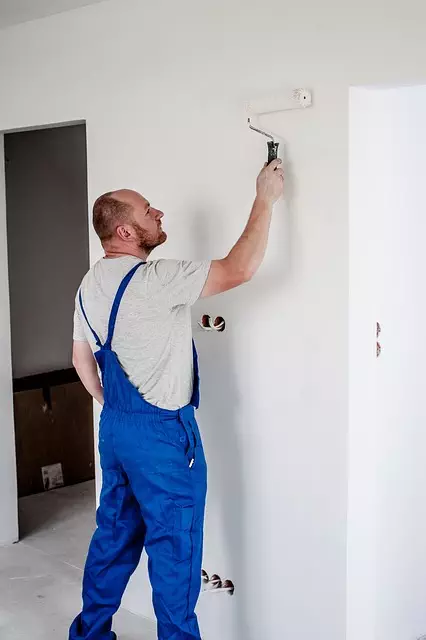Homeowners should be vigilant about foundation damage, as it critically impacts property value and structural integrity. Common causes include soil shifting, improper construction, and weather changes, leading to visible signs like wall cracks, uneven floors, and sticky doors. Early intervention is key; ignoring these issues can result in severe structural damage and costly repairs. Homeowners should look for subtle foundation distress indicators, such as cracks, water stains, or misaligned frames, and consult professionals specializing in Residential Foundation Repair for prompt assessment and solutions to prevent potential disasters.
“Foundations are the unsung heroes of any home, bearing the weight and supporting the structure. However, over time, various factors can lead to foundation damage, affecting not just the integrity of your home but also its safety. This article delves into the signs that indicate foundation problems, from visible cracks and uneven floors to misaligned doors and windows. Understanding these common causes and effects is crucial for homeowners, as it enables prompt action and the need for professional residential foundation repair services.”
Understanding Foundation Damage: Common Causes and Effects

Understanding Foundation damage is crucial for any homeowner, as it can significantly impact the structural integrity and value of a property. Common causes range from shifting soil, improper construction, to sudden changes in weather patterns, all leading to various effects like cracks in walls, uneven floors, and doors that stick or swing. These issues often indicate underlying problems within the foundation, which may require professional intervention for effective long-term solutions.
When it comes to residential foundation repair, addressing these signs early is key. Neglecting them can result in more severe structural damage over time, leading to costly repairs or even the need for complete replacement. Recognizing the subtle indicators of foundation distress enables homeowners to take timely action and avoid potential disasters, ensuring their home remains a safe and stable haven.
Identifying Visible Signs of Foundation Problems in Homes

When it comes to identifying foundation problems in homes, there are several visible signs that homeowners can look out for. One of the most obvious indicators is cracks in the walls or floors. These cracks can vary in width and may appear as hairline fractures or wider gaps. They often develop due to shifting soil beneath the structure, which can be a result of poor foundation support or water damage. Homeowners should also pay attention to uneven or bulging floors, doors that stick or swing slightly out of alignment, and windows that are no longer level.
Another telltale sign is distorted or misaligned walls, which might tilt inward or outward in certain areas. This can be caused by settlement issues or more severe foundation problems like heave (when the soil expands) or sinkage. Furthermore, water stains on ceilings or walls, especially around windows and doors, could indicate seepage or leaks, often stemming from a compromised foundation that allows moisture intrusion. If any of these signs are present, it’s advisable to consult with professionals specializing in residential foundation repair for further assessment and potential solutions.
Cracks: The Most Evident Indicator of Foundation Issues

Cracks in a foundation are often the most evident indicator of underlying issues that require attention from professionals specializing in residential foundation repair. Even the slightest fissures or splits can signal significant problems, as they typically form due to settlement, shifting soil, or structural instability. These cracks may appear as hairline fractures or wider gaps, and they can occur on the exterior or interior walls, floors, or ceiling.
While some minor cracks might be merely cosmetic, indicating no structural damage, it’s crucial not to ignore them. As time progresses, even seemingly insignificant cracks can expand, leading to more severe foundation problems. If you notice any cracks in your home’s foundation, it’s essential to consult with a professional who can assess the extent of the issue and provide effective solutions for residential foundation repair.
Uneven Floors: When Your Home's Level is Off

If you’ve noticed that your floors are no longer level, it might be a sign of foundation damage, particularly in homes built on clay or loose soil. Over time, shifting earth can cause settling and unevenness, resulting in bumps, cracks, or warped boards. This issue is not just aesthetically displeasing; it can also indicate a more severe problem with your home’s structural integrity.
In cases of residential foundation repair, uneven floors are often an early warning sign. Professional inspectors can perform a level survey to determine if your home has settled and, if so, to what extent. Early detection is crucial in preventing further damage and costly repairs down the line.
Door and Window Framing Misalignment: A Signal of Structural Stress

Door and window framing misalignment is a common yet often overlooked sign of foundation damage, particularly in older homes. Over time, shifting soil, settling, or even tree roots can exert pressure on the foundation, causing it to move and distort. This structural stress can lead to uneven doors and windows that stick, don’t close properly, or align awkwardly with their frames.
In cases of severe foundation damage, misaligned framing may be noticeable from the outside as well, with gaps appearing between door/window frames and their surrounding walls. If you observe such issues in your home, it’s crucial to contact a professional for an inspection, as it could indicate more significant problems that require expert residential foundation repair solutions.
Water Damage and Moisture Intrusion: Their Impact on Foundations

Water damage and moisture intrusion are significant issues that can compromise the integrity of a residential foundation repair. Over time, even minor leaks or high humidity levels can lead to extensive structural problems. When water seeps into the soil surrounding a home, it expands and contracts with temperature changes, exerting pressure on the foundation walls. This cyclical process can cause cracks, heaves, and settlement, resulting in uneven floors, leaning walls, and other visible signs of damage.
Moisture intrusion is especially harmful as it creates an ideal environment for mold growth and wood rot. These issues not only compromise the structural stability but also pose health risks to occupants. Prompt identification of water-related problems is crucial for effective residential foundation repair. Regular inspections, addressing leaks promptly, and ensuring proper drainage around the home are essential steps in mitigating these impacts and maintaining a solid foundation for years to come.
When to Call a Professional Residential Foundation Repair Service

If you notice signs of foundation damage, such as cracks in walls or floors, doors that stick, or uneven floors, it’s crucial to act promptly. While some minor issues might be addressable through DIY methods or simple repairs, more severe problems often require the expertise of a professional residential foundation repair service. Timely intervention is essential to prevent further deterioration and costly repairs down the line.
Calling in specialists for residential foundation repair is particularly important if structural instability is suspected, as they can conduct thorough inspections and provide accurate assessments. They employ advanced techniques and technology to diagnose the root causes, ensuring that any solutions implemented are effective, lasting, and safe.
